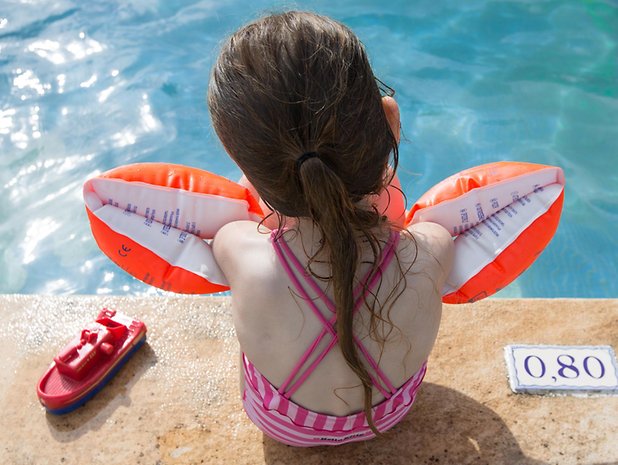Despite swimming lessons, 60 percent of children are still non-swimmers at the end of fourth grade. The number of drowned children is increasing dramatically. Schulportal-Columnist Sabine Czerny explores the question of why many children fail to learn how to swim safely in elementary school.


At least 504 people died in bathing accidents in Germany in 2018, as the German Life Saving Society (DLRG) reported earlier this year. Among the 71 fatalities in the age group up to 20 years, 26 were preschool and primary school children. The number of drowned children and adolescents rose by 38 percent in 2018 compared to the previous year.
These numbers are frightening, especially because it can be assumed that the number of drowned people will continue to increase in the coming years. According to a 2017 DLRG survey, around 60 percent of ten-year-olds are no longer safe swimmers.
Why is that? And what can be done to ensure the water safety of our children and young people?
One reason is surely that always more Swimming pools have been closed in recent years and will continue to be. No swimming lessons without a swimming pool – no question. But there are other reasons too.
Often there are less than 30 minutes for swimming lessons
At some elementary schools, swimming lessons take place in the neighboring town or in the neighboring school where there is a swimming pool. This is estimated to be a double hour during the school morning. So a time frame of 90 minutes is available. The children are taken to and from the swimming pool by bus, which usually takes over a quarter of an hour. It takes another few minutes for the children to change and shower and the formalities are completed. Especially in winter, when the hair of the children has to be dried with the few hair dryers, time must be planned very generously in order to be able to be back at school in time. Often, less than 30 minutes remain for swimming lessons with around 28 children in a pool, which is usually 20 by 8 meters in size. The children have to swim alternately so that each of them has enough space.
This double hour of swimming lessons per week is often shared by one year – regardless of the fact that swimming lessons are usually only in one yeargear takes place at all. This means that in a common four-course school, every student has about eight in his or her school life weeks Swimming lessons, i.e. eight double lessons, one of which also fails from time to time, due to a school project or an excursion or because the teacher is sick. There are usually few teachers at a school who are authorized to give swimming lessons.
Parents often replace missing supervisors in swimming lessons
Perhaps it is because the swimming class is not divided, as is often the case in handicrafts, but a single teacher has to teach 28 children. A second supervisor is required, who may also be guaranteed with the presence of a lifeguard. If the swimming pools have no lifeguards, the schools are in need … and again dependent on parents to accompany the class. Thank God there is always a parent who agrees to do this voluntary work. However, the teacher is responsible for the 28 children and swimming lessons.
In the past, almost all of the children could swim when they came to school. There were one or two non-swimmers who could be kept an eye on while giving instructions to the others. Nowadays – I would say – the relationship is rather like this: about three to eight children can swim well and do specific technical exercises, ten to 14 children somehow, sometimes very unsafe, stay afloat and need individual support, and six up to twelve children are absolute non-swimmers.
Many children are not familiar with the water
The problem with non-swimmers is that water is often not yet familiar to them. They are shy and are afraid to entrust themselves to this element or even to submerge part of their head under water. Each of these children would need a person to be with them. Who lovingly pulls through the water, splashes with him, slowly takes his head under water to the tip of his nose, exhales air with him in the water and rejoices with him, if only a little bit better.
It takes time … and above all it takes a human. Not just for getting used to the water, but also for the first swimming movements until the child feels safe in the water. The hand under the belly helps with the first swimming movements, which slowly loosens and is immediately back when the child becomes unsafe. The situation-guiding words help how the hand and foot movements have to be changed in order to swim better.
The teacher must not go into the water with the children
But a single teacher cannot do that. Simply because of the duty of supervision: You can only enter the water when all other children are out of the water. Buoyancy aids are good support for pure splashing and also for learning techniques and practice. However, if you use it to give the child safety while learning to swim, it is often deceptive, because the child does not gain safety out of itself. Children often do not dare to take off their swimming aids to swim alone. Or you would need someone to help you with this important step.
Teaching in a larger group only makes sense when the child has the basic requirements, that is, when it feels safe, when it no longer needs a person to support it and when it takes up and implements explanations on its own. In any case, 28 children are too many in a group; groups with eight children are just reasonable for a teacher.
I am quite worried that the problem will worsen. If there are fewer and fewer children who can swim, there will inevitably be fewer and fewer parents who can give their children the previous experience they need to learn to swim safely and well.
RELATED ITEMS
-

Learning to swim: How parents teach their children to swim themselves, Berlin newspaper
It’s this way . : The Berliner Zeitung has moved Nine tips: How parents teach their children how to swim 03.07.18, 1.30 p.m. 59…
-

ABC – learn letters – the German alphabet for children
pmq-software.com 3.0, 2 ratings Free in-app purchases possible Screenshots Description "Learn ABC letters" is an interactive educational game for…
-

Problematic math – why actually?
Many children have difficulties in math, often it becomes a problem subject. But why is that and what can parents do? mathematics…
-

ADHD and school – support, learning, teacher talks
ADHD, possibly combined with learning difficulties and developmental delays, quickly lead to frustration, fear of failure, and annoying…
